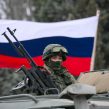
Commentary – Territorial Claims Can Work Two Ways: Russia and Ukraine
Publication: Eurasia Daily Monitor Volume: 6 Issue: 18
By:

The majority of Western comments on territorial claims arising from the breakup of the USSR focus on Russia’s demands against its neighbors. The best known, such as the Crimea and frozen conflicts in the Caucasus, are frequently mentioned in the Western media. Added to this are Russian comments that repeatedly have focused on the alleged “artificiality” of post-Soviet borders. Ukraine in particular is pointed out by Russian officials as an allegedly “artificial” and thereby “fragile” state.
These Western media reports and Russian comments overlook two facts: First, potential territorial revisions exist throughout the former USSR; and second, all of the borders of the 15 post-Soviet republics, especially the Russian Federation, are “arbitrary” and “artificial.” Countless post-colonial frontiers throughout the world are of a similar nature, and this is more the rule than the exception.
Belarus made territorial claims against Lithuania in the 1990s and Estonia and Russia have sparred over their border, the treaty for which was signed but never ratified by the Russian State Duma. The Trans-Dniestr region of Moldova, a frozen conflict since 1992, was part of the inter-war Ukrainian SSR as the Moldovan Autonomous Soviet Republic. Similar potential territorial disputes abound in the North Caucasus (e.g., Chechnya and Ingushetia), the South Caucasus (Georgia and Armenia), and Central Asia (Uzbekistan and Kyrgyzstan).
The most “artificial” post-Soviet republic is Russia, which was established as the residual home for what remained of the Tsarist empire after the non-Russian republics were created. Post-Soviet Russia could not return to the borders of a pre-imperial Russian nation-state because none had ever existed. Unlike England and France, which were nation-states before becoming empires, Russian city-states merged into Muscovy before it emerged as an empire in the eighteenth century.
Russia therefore resembles the Ottoman Empire inasmuch as the Turks also had no pre-imperial nation-state to fall back on when their empire collapsed after World War I. The difference between the Turks and the Russians is that a nationalist leader, Kemal Ataturk, came forward and forged a new Turkish nation-state, while no “Ataturk” appeared in late Soviet Russia and, unlike his Turkish or Ukrainian counterparts, President Boris Yeltsin never prioritized nation-building.
Alone of the 15 Soviet republics, the Russian SFSR has never declared independence from the USSR. Russia’s annual “independence day” is therefore a myth, as it derives from the June 1990 declaration of sovereignty within the USSR.
Three decades prior to the transfer of the Crimea in 1954 from the Russian SFSR to the Ukrainian SSR, larger territories were transferred from Ukraine to Russia. The Ukrainian-Russian border was the subject of confrontation between the collapse of the Russian Empire in 1917 and the territorial adjustments made in the two years after the creation of the USSR in 1922.
Ukraine’s pro-independence governments fought with the White and Bolshevik forces who both opposed the creation of an independent Ukraine. Although the Volunteer Army of the Whites was dominated by the liberal Kadets, they defended Russia’s unity and indivisibility, opposed a federally reconstituted empire, and especially denounced “Little Russian” (Ukrainian) autonomy, let alone forging an independent state separate from Russia.
The Starodub region northeast of Chernihiv Oblast was part of Ukraine under the 1918 Treaty of Brest-Litovsk but was transferred to Russia. Other areas with ethnic Ukrainian majorities transferred to Russia were Kursk and Voronezh Oblasts east of the Ukrainian oblasts of Sumy, Kharkiv, and Luhansk. The Taganrog region of Russia’s Rostov Oblast, east of Ukraine’s Donetsk Oblast, was also contested by Ukraine and Russia. These areas adjacent to the border of the Ukrainian SSR were claimed by Kyiv, because they were 65 to 75 percent ethnic Ukrainian and, together the Kuban, contained two million Ukrainians (see three maps in Vasyl Boyechko et al, Kordony Ukrainy: Istorychna Retrospektyva ta Suchasnyi Stan, Kyiv, 1994).
The Kuban region of Russia’s Northern Caucasus had been populated by the Ukrainian (Black Sea) Cossacks from the eighteenth century. After the Ukrainian Cossack State was absorbed under Catherine the Great into the Tsarist empire, Ukrainian Cossack forces were disbanded, except in the Kuban. There Ukrainian Cossacks were permitted to maintain the only Ukrainian Cossack unit (the “Kuban Cossack Host”) until the end of Tsarist rule; it was one of 12 Cossack armies in the Russian Empire.
From 1917 to 1920 political forces in the Kuban supported opposing tendencies, some backing the White armies while others called for unification with independent Ukraine. The large ethnic Ukrainian majority in the Kuban gave rise to territorial demands by Ukrainian national communists who ran Ukraine until the imposition of Joseph Stalin’s great terror in the late 1920s and early 1930s and an artificial famine in Ukraine in 1933.
The famine was permitted to spread from Ukraine and devastated the largely ethnic Ukrainian Kuban region. This, coupled with the replacement of Ukrainian by Russian in the schools starting in 1934, transformed the Kuban’s ethnic composition. The Kuban became Russified during the course of the following decades, although Ukrainian-language pronunciations can still be heard in local spoken Russian (for example. Mikhail Gorbachev’s Russian).
The 1989 Soviet census gave a total of 44.2 million Ukrainians in the USSR of whom 37.4 million lived in the Ukrainian SSR. Of the 6.8 million living elsewhere, the largest group was 3.7 million in the Russian SFSR.
Aside from 247,000 Ukrainians who were living in Moscow, a similarly large number lived in the Tyumen Oblast of Western Siberia. They had arrived in the Leonid Brezhnev era to provide technical expertise in gas exploration (Ukraine was an important center of gas expertise in the former USSR, especially in western Ukraine. where gas storage facilities are located).
Russia, in recognizing the independence of South Ossetia and Abkhazia, has opened up a potential Pandora’s Box of territorial claims throughout the former USSR that could backfire on Moscow.




